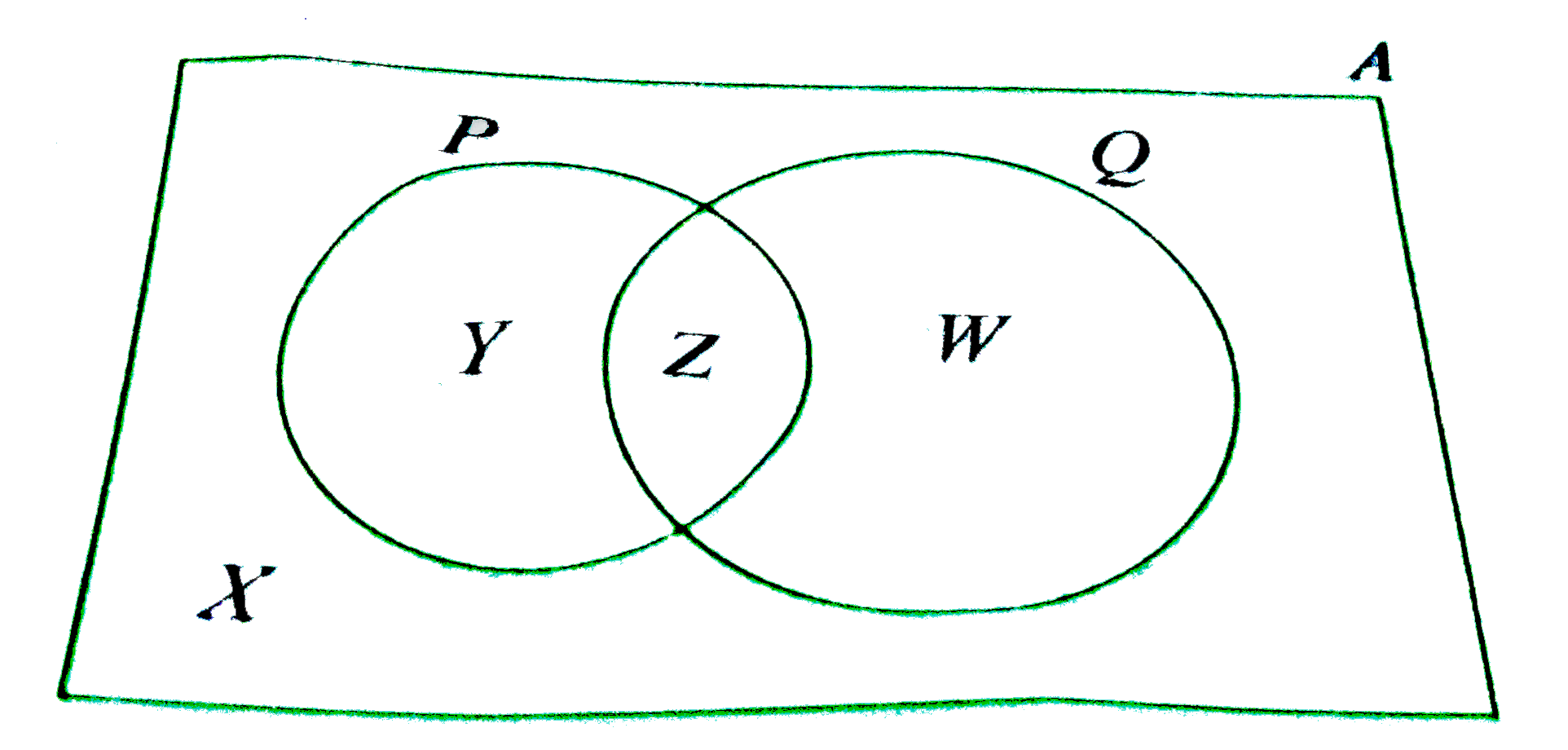Let A be a set containing elements. A subset P of the set A is chosen at random. The set A is reconstructed by replacing the elements of P, and another subset Q of A is chosen at random. The probability that P∩Q contains exactly m(m<n) elements, isSolution in Bengali
3n−m4n
.nCm.3m4n
.nCm.3n−m4n
none of these
The correct Answer is:C

Sets P and Q are subsets of set A. Sets P and Q are dividing set A in four regions X, Y, Z and W.
∴ Total number of cases
= Number of ways in which n elements can be distributed in four regions = 4n
If set (P∩Q) has exactly m elements, we can select these m elements in .nCm ways. Remaining n - m elements can be distributed in the regions X, Y and W in 3n−m ways.
∴ Number of favourable ways = .nCm×3n−m
∴ Required probability = .nCm×3n−m4n
Topper's Solved these Questions
- BOOK - CENGAGE PUBLICATIONCHAPTER - PROBABILITY I EXERCISE - Comprehension14videos
PROBABILITY I
- BOOK - CENGAGE PUBLICATIONCHAPTER - PROBABILITY I EXERCISE - Match2videos
PROBABILITY I
- BOOK - CENGAGE PUBLICATIONCHAPTER - PROBABILITY I EXERCISE - Exercise 9.37videos
PROBABILITY I
- BOOK - CENGAGE PUBLICATIONCHAPTER - PROBABILITYEXERCISE - All Questions470videos
PROBABILITY
- BOOK - CENGAGE PUBLICATIONCHAPTER - PROBABILITY IIEXERCISE - MULTIPLE CORRECT ANSWER TYPE6videos
PROBABILITY II
Similar Questions
A shopping mall is running a scheme: Each packet of detergent SURF contains a coupon which bears letter of the word SURF, if a person buys at least four packets of detergent SURF, and produce all the letters of the word SURF, then he gets one free packet of detergent.
If a person buys 8 such packets, then the probability that he gets two free packets is02:51View Solutionn whole are randomly chosen and multiplied
Column I, Column II
The probability that the last digit is 1,3,7, or 9 is, p. 8n−4n10n
The probability that the last digit is 2,4,6, or 8 is, q. 5n−4n10n
The probability that the last digit is 5 is, r. 4n10n
The probability that the last digit is zero is, s. 10n−8n−5n+4n10n02:23View SolutionAandB are two candidates seeking admission in IIT. The probability that A is selected is 0.5 and the probability that AandB are selected is at most 0.3. Is it possible that the probability of B getting selected is 0.9?
03:45View SolutionA coin is tossed three times, consider the following events. A : ‘No head appears’, B: ‘Exactly one head appears’ and C: ‘Atleast two appear’. Do they form a set of mutually exclusive and exhaustive events?
01:32View SolutionLet EandF be two independent events. The probability that exactly one of them occurs is 1125 and the probability if none of them occurring is 225. If P(T) denotes the probability of occurrence of the event T, then (a) P(E)=45,P(F)=35 (b) P(E)=15,P(F)=25 (c) P(E)=25,P(F)=15 (d) P(E)=35,P(F)=45
01:41View SolutionA is a set containing n elements. A subset P of A is chosen at random. The set A is reconstructed by replacing the elements of P. A subset Q is again chosen at random. The probability that P and Q are disjoint sets, is
01:55View SolutionA is a set containing n elements. A subset P of A is chosen at random. The set A is reconstructed by replacing the elements of P. A subset Q is again chosen at random. The Probability that P∪Q=A, is
01:52View SolutionA is a set containing n elements. A subset P of A is chosen at random. The set A is reconstructed by replacing the elements of P. A subset Q is again chosen at random. The Probability that P∩Q contain just one element, is
02:19View SolutionA is a set containing n elements. A subset P of A is chosen at random. The set A is reconstructed by replacing the elements of P. A subset Q is again chosen at random. The Probability that P∪Q contain just one element, is
04:41View SolutionA is a set containing n elements. A subset P of A is chosen at random. The set A is reconstructed by replacing the elements of P. A subset Q is again chosen at random. The Probability that Q is a subset of P, is
View SolutionA is a set containing n elements. A subset P of A is chosen at random. The set A is reconstructed by replacing the elements of P. A subset Q is again chosen at random. The Probability that P and Q have equal number of elements, is
View SolutionA is a set containing n elements. A subset P of A is chosen at random. The set A is reconstructed by replacing the elements of P. A subset Q is again chosen at random. The probability that Q contains just one element more than P, is
View SolutionLet A be a set containing elements. A subset P of the set A is chosen at random. The set A is reconstructed by replacing the elements of P, and another subset Q of A is chosen at random. The probability that P∩Q contains exactly m(m<n) elements, is
03:26View SolutionLet A be a set containing elements. A subset P of the set A is chosen at random. The set A is reconstructed by replacing the elements of P, and another subset Q of A is chosen at random. The probability that P∩Q contains exactly m(m<n) elements, is
02:21View SolutionA is a set containing n elements. A subset P of A is chosen at random. The set A is reconstructed by replacing the elements of P. A subset Q of A is again chosen at random. Find the probability that
P∪Q=A05:21View SolutionA is a set containing n elements. A subset P of A is chosen at random. The set A is reconstructed by replacing the elements of P. A subset Q of A is again chosen at random. Find the probability that
P∪Q contains exactly r elements02:24View Solution

